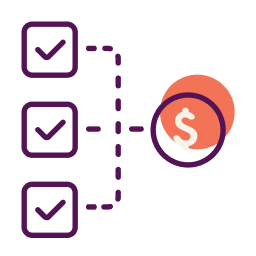- The double-entry bookkeeping system is a bookkeeping method to track two sides of a general ledger for each business transaction: debits and credits.
- This accounting method helps accountants and small business owners know right away if there’s an error in their bookkeeping because the two sides of the ledger should balance out.
- Using this method can increase the accuracy of a business’s books, and it’s usually easiest if the calculations are done by accounting software or a service.
- This article will discuss what double-entry accounting is, why double-entry accounting can be a good tool for your business, and how to implement it.
What Is Double-Entry Accounting?
Double-entry accounting is a method of bookkeeping that records financial transactions by creating entries in at least two different accounts. It’s based on the principle that every transaction has two sides — an equal debit and credit. This system helps to increase accuracy and maintains the balance of a business’s financial records.
In double-entry accounting, each transaction affects two accounts: one account is debited and another account is credited by an equal amount. The debits and credits must always balance, meaning that the total debits must equal the total credits for each transaction and the overall financial records.
The double-entry accounting equation is:
Assets = Liabilities + Owner’s Equity
Here are some key parts of double-entry accounting that are worth familiarizing yourself with:
- Debits and credits: In the double-entry system, debits and credits are used to record transactions. Debits are typically recorded on the left side of an account, while credits are recorded on the right side. Different accounts have specific rules for whether an increase or decrease is represented by a debit or credit.
- Types of accounts: Accounts are categorized into five main types: asset accounts, liability accounts, equity accounts, revenue accounts, and expense accounts. Each account type has a normal balance side (debit or credit). For example, asset accounts and expenses increase with a debit entry and decrease with a credit entry, while equity, revenue, and liability accounts increase with a credit and decrease with a debit.
- T-Accounts: T-Accounts are a visual representation of the double-entry system. Each account is represented as a T-shape, with debits on the left side and credits on the right side. The left side of the T-account is often referred to as the “debit side,” and the right side as the “credit side.”
- General ledger: The general ledger is a collection of all accounts used in double-entry accounting. It contains the individual T-accounts for each account and serves as a centralized record of all transactions.
- Trial balance: A trial balance is prepared to verify the accuracy of the double-entry system. It lists all the account balances, ensuring that the total debits equal the total credits. If the trial balance doesn’t balance, it indicates an error that needs to be identified and corrected.
Most accounting software automatically performs double-entry accounting behind the scenes.
Single-Entry vs. Double-Entry Accounting
Single-entry and double-entry accounting are two different methods used in bookkeeping to record financial transactions. Here’s a brief comparison of these two main accounting concepts.
Single-entry accounting
Single-entry bookkeeping is a simple and less formal bookkeeping method commonly used by small businesses or individuals with relatively straightforward financial operations. In this method, each financial transaction is recorded only once, typically in a single column or register.
Transactions are recorded in a chronological order, usually in a journal or a ledger. The entries typically include details such as date, description, and amount. There are also usually only a limited number of accounts associated with the accounting process, like cash, accounts receivable, accounts payable, and possibly a few other accounts that are important to the business.
There is more limited accuracy with single-entry accounting since only one entry is made for each transaction. So single-entry accounting doesn’t ensure accurate tracking of debits and credits or maintain a formal balance sheet. It provides a basic overview of income and expenses, but it may not capture all the financial complexities of a business.
It also only allows for simplified reporting. Single-entry accounting may be sufficient for small businesses to fulfill basic reporting requirements, such as preparing income statements or calculating tax liabilities. However, it may not provide the level of detail and accuracy needed for more in-depth financial analysis.
Double-entry accounting
A double-entry accounting system is a more sophisticated and widely adopted method that provides a comprehensive view of a company’s financial transactions and balances. It follows the fundamental principle that each transaction has two sides, with equal debits and credits, also called dual recording. Each transaction is recorded in at least two different accounts, with one account debited and another credited. This ensures that debits and credits are balanced and that the accounting equation is always maintained.
This method relies on a chart of accounts where each accounting entry is tracked, including multiple account categories like assets, liabilities, equity, revenue, and expenses. Each account category has specific rules for whether debits or credits increase or decrease the account balance.
Double-entry accounting is considered more robust and suitable for businesses of all sizes, especially those with complex financial transactions and reporting requirements. It offers greater accuracy, comprehensive financial analysis, and adherence to generally accepted accounting principles and standards.
Small businesses looking to rely on double-entry bookkeeping will typically use an accounting software or service to do the journal entry and analysis for them.
Advantages of Double-Entry Accounting
Double-entry accounting provides several benefits, including:
- Increased accuracy: The system helps ensure that every financial transaction is recorded in a balanced manner, minimizing errors and providing an accurate representation of a company’s financial position.
- Financial analysis: The use of double-entry accounting enables financial analysis by providing detailed and organized information about various accounts and their relationships.
- Auditability: The system provides a clear audit trail, making it easier for auditors to review and verify financial records.
- Financial statements: Double-entry accounting forms the foundation for preparing financial statements such as the balance sheet, income statement, and cash flow statement, which provide valuable insights into a company’s financial performance.
Overall, double-entry accounting is a widely used method that helps businesses maintain accurate financial records, improve financial health, enhance recordkeeping, as well as facilitates effective financial management and decision-making.
How to Implement Double-Entry Accounting
If you’re a small business owner, a single-entry accounting system may work fine for you. However, if you enter a growth phase, want to bring on investors, or plan to apply for small business loans, you’ll want to consider switching to a double-entry system.
To start using a double-entry bookkeeping system, you’ll want to upgrade from an Excel spreadsheet. Using an accounting software or service is a great idea to save you from making costly errors and spending too much time with this type of financial accounting.
Using Nav to find the right accounting software is the simplest way to get the right option for your business. For more on how to choose accounting software, don’t miss this guide from Nav’s experts.
Common Misconceptions About Double-Entry Accounting
Despite its widespread use, there are several common misconceptions about double-entry accounting. Here are a few of them:
- It’s complicated: Many people perceive double-entry accounting as complex and difficult to understand. While it does involve certain principles and rules, once you grasp the basic concepts, it becomes more intuitive. Double-entry accounting provides a structured framework for recording and organizing financial transactions, ensuring accuracy, and maintaining the balance of accounts.
- Debits are positive and credits are negative: It’s a common misconception that debits and credits always represent positive and negative values, respectively. In reality, debits and credits are simply used to denote the increase or decrease in specific account balances. The positive or negative nature of a value depends on the account category and its normal balance side, rather than the debit or credit designation.
- It’s only useful for businesses: While double-entry accounting is widely associated with business accounting, it can also be applied to personal finances or other non-business entities.
- You’ll eliminate errors: While double-entry accounting reduces the chances of errors, it does not get rid of them entirely. Mistakes can still occur during data entry, classification, or reconciliation processes. It’s important to perform regular reviews and use proper accounting software to minimize errors and ensure your financial records are accurate.
- It’s time-consuming: Some people think double-entry accounting is a time-consuming process due to the need to record transactions in multiple accounts. However, with the availability of accounting software and streamlined bookkeeping procedures, the process can be significantly automated, saving time and effort.
- It’s only for financial experts: While professional accountants and bookkeepers are well-versed in double-entry accounting, it does not mean that individuals without extensive accounting knowledge can’t understand and implement it. With basic understanding and the right tools, anyone can learn and apply double-entry accounting principles to manage their financial records effectively.
Understanding these misconceptions can help demystify double-entry accounting and highlight the benefits for accurate financial recording, reporting, and analysis. It’s a valuable tool that can provide structure and reliability in managing both business and personal finances.
Frequently Asked Questions About Double-Entry Accounting
This article was originally written on August 11, 2023.



Have at it! We'd love to hear from you and encourage a lively discussion among our users. Please help us keep our site clean and protect yourself. Refrain from posting overtly promotional content, and avoid disclosing personal information such as bank account or phone numbers.
Reviews Disclosure: The responses below are not provided or commissioned by the credit card, financing and service companies that appear on this site. Responses have not been reviewed, approved or otherwise endorsed by the credit card, financing and service companies and it is not their responsibility to ensure all posts and/or questions are answered.